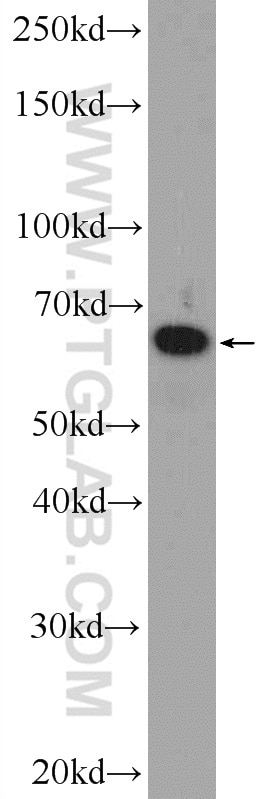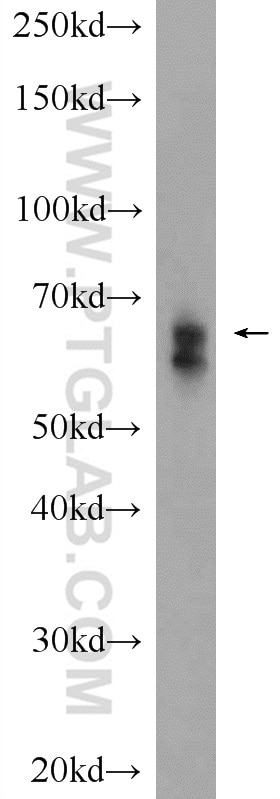Filter:
Tested Applications
| Positive WB detected in | A549 cells, rat lung tissue |
Recommended dilution
| Application | Dilution |
|---|---|
| Western Blot (WB) | WB : 1:500-1:2000 |
| It is recommended that this reagent should be titrated in each testing system to obtain optimal results. | |
| Sample-dependent, Check data in validation data gallery. | |
Published Applications
| KD/KO | See 1 publications below |
| WB | See 3 publications below |
| IP | See 1 publications below |
Product Information
23902-1-AP targets RBM47 in WB, IP, ELISA applications and shows reactivity with human, rat, mouse samples.
| Tested Reactivity | human, rat, mouse |
| Cited Reactivity | human, mouse |
| Host / Isotype | Rabbit / IgG |
| Class | Polyclonal |
| Type | Antibody |
| Immunogen | RBM47 fusion protein Ag20984 Predict reactive species |
| Full Name | RNA binding motif protein 47 |
| Calculated Molecular Weight | 593 aa, 64 kDa |
| Observed Molecular Weight | 64 kDa |
| GenBank Accession Number | BC126261 |
| Gene Symbol | RBM47 |
| Gene ID (NCBI) | 54502 |
| RRID | AB_2879356 |
| Conjugate | Unconjugated |
| Form | Liquid |
| Purification Method | Antigen Affinity purified |
| UNIPROT ID | A0AV96 |
| Storage Buffer | PBS with 0.02% sodium azide and 50% glycerol pH 7.3. |
| Storage Conditions | Store at -20°C. Stable for one year after shipment. Aliquoting is unnecessary for -20oC storage. 20ul sizes contain 0.1% BSA. |
Protocols
| Product Specific Protocols | |
|---|---|
| WB protocol for RBM47 antibody 23902-1-AP | Download protocol |
| Standard Protocols | |
|---|---|
| Click here to view our Standard Protocols |
Publications
| Species | Application | Title |
|---|---|---|
Cell Death Discov RBM47 inhibits hepatocellular carcinoma progression by targeting UPF1 as a DNA/RNA regulator.
| ||
Apoptosis Deubiquitinating enzyme OTUD4 stabilizes RBM47 to induce ATF3 transcription: a novel mechanism underlying the restrained malignant properties of ccRCC cells | ||
Korean J Physiol Pharmacol Curcumin modulates the apolipoprotein B mRNA editing by coordinating the expression of cytidine deamination to uridine editosome components in primary mouse hepatocytes. |



